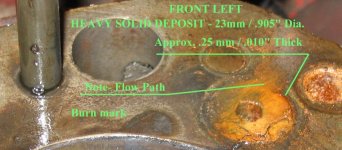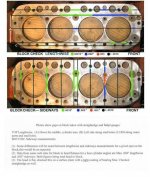Currently working on a friends MGB he had the head machined and refitted this with a new gasket, fortunately the car had very little use since due to a head gasket water leak mainly front LH side.
Removing the head I found two contributing factors on the block.(1)Stud threads had pulled up by 0.1mm/.004" I have now chamfered these off with a 90 degree cutter.(2)The main problem was a build up of "gunk"a heavy and hard rust deposit surrounding the water passage holes through the block, mainly around the five large gasket holes, 3 LH and 2 RH side. This deposit was 23mm/.905" dia.and approx. .25mm/.010" thick. The disturbing aspect was the new gasket fitted was seated on these deposits the corresponding holes being 19mm/.748" dia. with the rolled over sealing ring being 22mm/.866". so clearly the new gasket could not seal. The earlier gasket fitted must have had larger holes around these water passages than the new one. I would have thought these gaskets would be made to standard dimensions, no doubt materials could differ. Possibly one was an El Chepo ?
Have since levelled these areas off using a flat steel block and 400 W&D paper, this also removed a slight burn mark on the block at the top of #1 cylinder at 10 o'clock from the front,ie in the direction of the water leakage. Good thing the engine was not run for long, as obviously there was water and gas leaking out together.
I am puzzled by the different hole sizes around the water ports is this common ? Maybe some one with with a MGB head gasket laying around would like to check and comment.
Being a "newbie" this is my first postlng I don't if I can attach a photo of the area in question, have one which shows the problem even the flow path of the water.Will try.
Removing the head I found two contributing factors on the block.(1)Stud threads had pulled up by 0.1mm/.004" I have now chamfered these off with a 90 degree cutter.(2)The main problem was a build up of "gunk"a heavy and hard rust deposit surrounding the water passage holes through the block, mainly around the five large gasket holes, 3 LH and 2 RH side. This deposit was 23mm/.905" dia.and approx. .25mm/.010" thick. The disturbing aspect was the new gasket fitted was seated on these deposits the corresponding holes being 19mm/.748" dia. with the rolled over sealing ring being 22mm/.866". so clearly the new gasket could not seal. The earlier gasket fitted must have had larger holes around these water passages than the new one. I would have thought these gaskets would be made to standard dimensions, no doubt materials could differ. Possibly one was an El Chepo ?
Have since levelled these areas off using a flat steel block and 400 W&D paper, this also removed a slight burn mark on the block at the top of #1 cylinder at 10 o'clock from the front,ie in the direction of the water leakage. Good thing the engine was not run for long, as obviously there was water and gas leaking out together.
I am puzzled by the different hole sizes around the water ports is this common ? Maybe some one with with a MGB head gasket laying around would like to check and comment.
Being a "newbie" this is my first postlng I don't if I can attach a photo of the area in question, have one which shows the problem even the flow path of the water.Will try.

 Hi Guest!
Hi Guest!

 smilie in place of the real @
smilie in place of the real @
 Pretty Please - add it to our Events forum(s) and add to the calendar! >>
Pretty Please - add it to our Events forum(s) and add to the calendar! >> 


